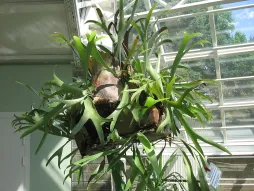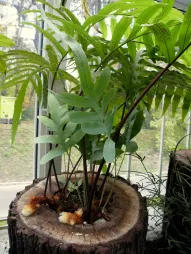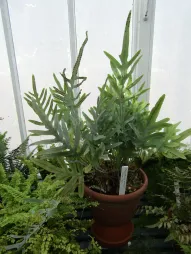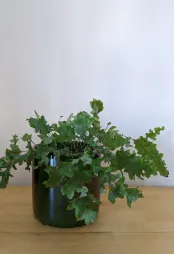Platycerium coronarium, a fern with fan-shaped fronds
Are you looking for an XXL hanging lamp to adorn the cathedral ceiling of your loft? Consider a Platycerium coronarium. With its huge, strange foliage, this fern from the Polypodiaceae family will transform your living room into a cabinet of curiosities.
How to recognize Platycerium coronarium?
Platycerium coronarium is an epiphytic fern with a drooping habit. It can measure up to 150 centimetres wide and three metres high.
The base of the sterile fronds resembles a fan. It is rounded and strongly ribbed. The top is lobed and almost bifurcated. As they age, green fronds form a basket that covers their support. They trap insects and dead leaves inside, providing the plant with nutrients.
Fertile grey-green fronds measure up to two meters long. They grow on the outside of the sterile fronds and fall back gently. They are highly indented, resembling the meshes of a net or lace.
Fertile fronds bear brown sporangia on their underside. These contain spores that enable the plant to reproduce.
Platycerium coronarium is non-toxic. It is safe for you and your pets.
Our maintenance tips
Pay particular attention to the choice of container or support. After a few repottings, your Platycerium coronarium will cover it with its fronds. You won't be able to change pots.
Watering
You need to let the substrate dry out between waterings. The best way to tell if your plant is thirsty is to observe it: when the fronds droop, it's time to give it a drink.
Fill a basin with rainwater at room temperature. Immerse the support (basket, wooden board) and soak for at least 15 minutes during the growth phase. During the resting period, a two-minute soaking is sufficient. Before returning your Platycerium coronarium to its place, make sure any excess water has drained off.
Green fronds are covered in bloom. Make sure you don't touch them while watering! You risk damaging them.
Spray
Spray foliage with rainwater at room temperature. This misting helps combat pests and improves hygrometry.
Repotting
In spring, transfer your Platycerium coronarium to a larger pot, so that it can continue to grow.
To repot your Platycerium coronarium, you'll need an openwork orchid basket. Line the bottom and sides with blond peat or sphagnum moss. Pour in a bed of potting soil for epiphytic orchids.
Meanwhile, soak the rootball of your Platycerium coronarium. When damp, place the plant in the basket. You can add some sphagnum moss around the edges to help the plant stand upright in the center of the container.
Water and allow excess to drain away.
Fertilization
You can stimulate the development of your plant during its growth phase, in spring and summer, with fertilizer.
Addgreen plant fertilizer to watering water.
Cutting
Cutting is carried out during the strong growth phase, generally in spring and early summer.
Separate the shoots using a clean, sharp knife, without damaging the mother plant. Be sure to remove at least one frond and some roots.
Obtain an openwork basket, such as an orchid basket. Line it with blond peat moss. Add a bed of substrate for epiphytic orchids at the bottom. Plant your Platycerium coronarium and pour in a layer of substrate.
Water generously and leave the rootball to drain before replacing the container.
Disease / Threat
Information
| Family | Polypodiaceae - Polypodiaceae |
| Type | Platycerium - Platycerium |
| Species | Platycerium coronarium - Platycerium coronarium |
| Lifecycle | Perennial |
| Foliage | Evergreen |
| Exposure | |
| Substrat | |
| Planting method |
In pots |
| Categories | |
| Tag |
Large pot |
| Origin |
Southeast Asia |
| Hardiness (USDA) | 12a |
| Leaf color |
|
Discover plants from the same family

Elkhorn fern
Discover

Golden polypod
Discover

Phlebodium aureum 'Blue Star
Discover

Phlebodium aureum 'Davana
Discover
















